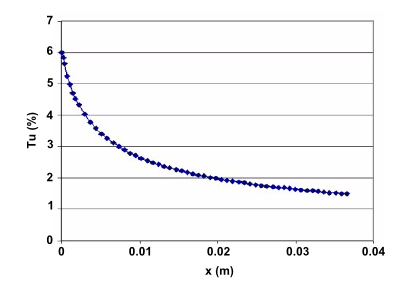It has been observed that the turbulence intensity specified at an inlet can decay quite
rapidly depending on the inlet viscosity ratio () (and hence turbulence eddy frequency). As a result, the local turbulence
intensity downstream of the inlet can be much smaller than the inlet value (see Figure 4.5: Exemplary Decay of Turbulence Intensity (Tu) as a Function of Streamwise Distance
(x)). Typically, the larger the inlet viscosity ratio, the smaller
the turbulent decay rate. However, if too large a viscosity ratio is specified (that is, >
100), the skin friction can deviate significantly from the laminar value. There is experimental
evidence that suggests that this effect occurs physically; however, at this point it is not clear
how accurately the transition model reproduces this behavior. For this reason, if possible, it is
desirable to have a relatively low (that is,
1 – 10) inlet viscosity ratio and to estimate the inlet value of
turbulence intensity such that at the leading edge of the blade/airfoil, the turbulence intensity
has decayed to the desired value. The decay of turbulent kinetic energy can be calculated with
the following analytical solution:
(4–191) |
For the SST turbulence model in the freestream the constants are:
(4–192) |
The time scale can be determined as follows:
(4–193) |
where is the streamwise distance downstream of the inlet and
is the mean convective velocity. The eddy viscosity is defined as:
(4–194) |
The decay of turbulent kinetic energy equation can be rewritten in terms of inlet turbulence
intensity () and inlet eddy viscosity ratio (
) as follows:
(4–195) |
You should ensure that the values around the body of interest roughly satisfy
>0.1%. For smaller values of
, the reaction of the SST model production terms to the transition onset becomes
too slow, and transition can be delayed past the physically correct location.



